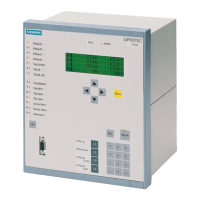'(& )( )'& &) ( &!& ")& &$(( $# Ć %&( $# #)" &&#$
6 - 20
Siemens AG ⋅ May 1998
During normal service of the station protection, it may
be desirable to influence the device temporarily. An
example may be to take a bay out of service during
maintenance work.
This taking out of service can be performed at the bay
unit via binary input or at the bay unit or master unit
via operation.
The input/output module EAZ1 has
7 binary inputs (BI1-7).
The binary inputs have fixed allocations.
Table 6.1 Allocation of the binary inputs
Binary inputs Short text Logical function
1 >LED acknowl LED acknowledgement
2 >Flt rec freeze Freeze in fault record buffer (generate fault record)
3 >Flt rec rel Release fault record buffer (erase the stored fault records)
4 >BloDifSup rel Release blocking after pick-up of differential current supervision
5 >BloISO Flt rel Release blocking after isolator failure
6 >Eventbuf erase Erase contents of the operations and fault record buffer
7 free
> R e l e a s e f l t r e c
The binary input erases stored fault records. New
fault records can now be stored.
> F l t r e c f r e e z e
The binary input generates a fault record. Pre-fault
and post-fault times here refer to the binary signal
input.
> B l o D i f S u p r e l
The binary signal releases the protection which had
been blocked by the differential current supervision.
This function is active only when the parameters
and/or are set to "blocking
with storage".
> B l o I S O F l t r e l
The binary input causes release of the protection
blocking initiated by isolator failure.
This function is only active if the parameter
is set to "Blocking with storage".

